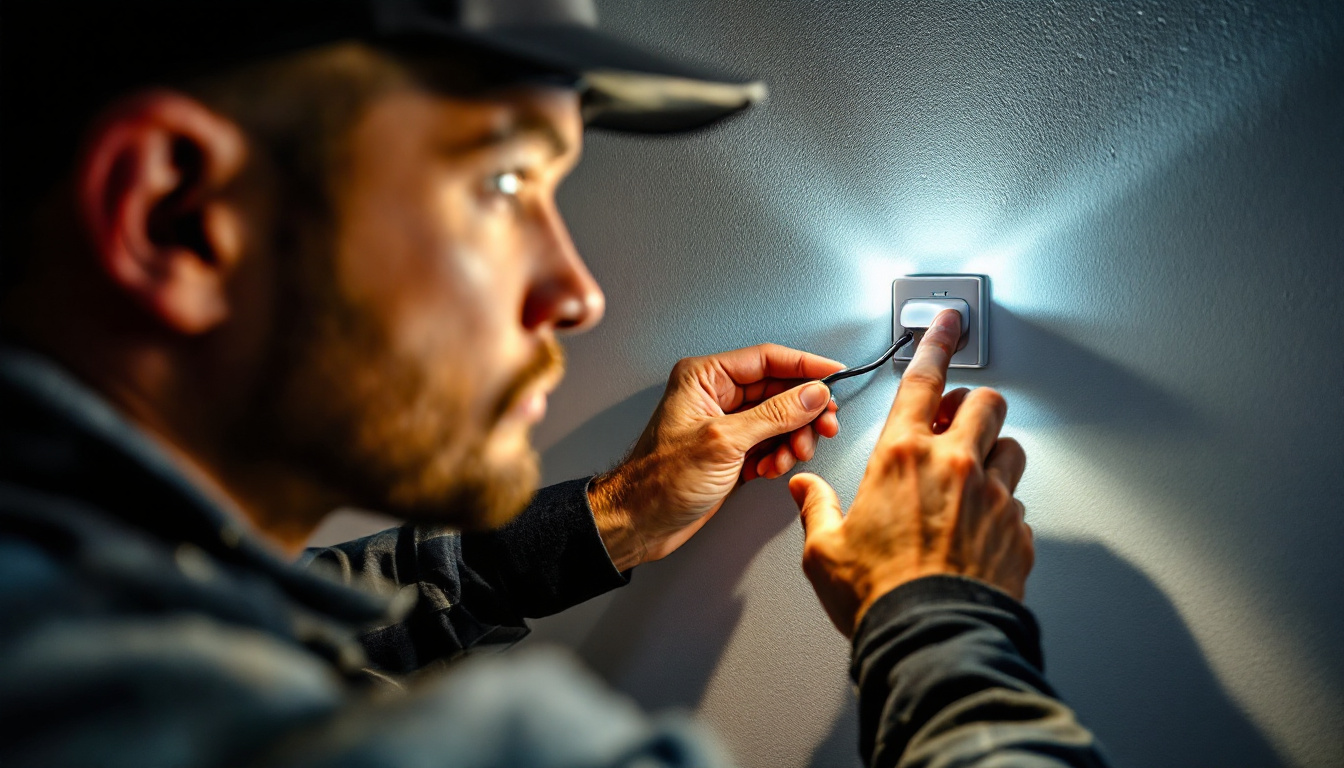
In the ever-evolving world of lighting technology, solar LED systems have emerged as a popular choice among lighting contractors. As energy efficiency and sustainability become increasingly important, understanding the intricacies of solar LED lighting can provide a competitive edge. This article aims to break down the essential components, benefits, and installation considerations of solar LED lighting systems in a concise manner.
Solar LED lighting combines solar energy with light-emitting diode (LED) technology to create an efficient and sustainable lighting solution. This section delves into the fundamental aspects of how these systems work and their key components.
At the core of a solar LED system is the solar panel, which captures sunlight and converts it into electricity. This electricity is stored in a battery, allowing the lights to operate even when the sun isn’t shining. The LED lights are powered by this stored energy, providing illumination during the night or in low-light conditions. The integration of solar technology with LED lighting not only reduces reliance on conventional power sources but also minimizes the carbon footprint associated with traditional lighting methods.
Solar LED systems typically include a few critical components: the solar panel, battery, LED fixtures, and a charge controller. The charge controller regulates the flow of electricity to and from the battery, ensuring it is charged efficiently and preventing overcharging or deep discharging. This intelligent management of energy flow is essential for maximizing the lifespan of the system and ensuring reliable performance throughout its operational life.
The efficiency and effectiveness of a solar LED system depend on the quality of its components. Here’s a closer look at each:
Moreover, the integration of smart technology into solar LED systems is revolutionizing how we interact with outdoor lighting. Many systems now come equipped with motion sensors and smart controls that adjust brightness based on surrounding light levels or detect movement, ensuring that energy is used only when necessary. This not only enhances security but also contributes to further energy savings, making solar LED lighting an even more attractive option for eco-conscious consumers.
As the demand for sustainable energy solutions continues to grow, solar LED technology is poised to play a crucial role in the future of lighting. With ongoing research and development, we can expect to see even more efficient systems that harness renewable energy, reduce energy costs, and provide reliable illumination for a variety of settings. This evolution reflects a broader commitment to sustainability and innovation in the face of global energy challenges.
Solar LED lighting offers numerous advantages that make it an attractive option for lighting contractors and their clients. Understanding these benefits can help contractors make informed recommendations to their customers.
One of the most significant benefits of solar LED lighting is its energy efficiency. By harnessing solar energy, these systems reduce reliance on grid electricity, leading to lower energy bills. Over time, the initial investment in solar LED technology can result in substantial savings.
Moreover, many regions offer incentives or rebates for installing solar lighting systems, further enhancing their cost-effectiveness. Contractors can leverage these financial benefits to persuade clients to consider solar LED options. As energy prices continue to rise, the long-term savings associated with solar LED lighting become increasingly appealing, allowing clients to allocate resources to other important projects or upgrades.
Solar LED lighting systems contribute to a reduction in carbon footprints. By utilizing renewable energy, they help decrease greenhouse gas emissions associated with traditional lighting solutions. This environmentally friendly aspect appeals to clients who prioritize sustainability and wish to enhance their corporate social responsibility.
Additionally, solar LED systems do not require extensive wiring or trenching, minimizing the environmental disruption often associated with traditional lighting installations. The use of solar energy also means that these systems can operate independently of the grid, making them particularly valuable in areas prone to power outages or in regions where electricity is scarce. This resilience not only benefits the environment but also provides peace of mind to clients who depend on reliable lighting for safety and security.
Solar LED lighting systems are versatile and can be used in various applications, from street lighting to landscape illumination. Their adaptability makes them suitable for both urban and rural settings.
Contractors can install solar LED lights in parks, parking lots, pathways, and even residential areas. The ability to deploy these systems in remote locations without access to electrical infrastructure further expands their usability. Furthermore, advancements in solar technology have led to innovative designs that can blend seamlessly with architectural styles or natural landscapes, enhancing aesthetic appeal while providing functional lighting. This versatility allows contractors to cater to a broader range of client needs, ensuring that every project can benefit from the advantages of solar LED lighting.
While solar LED systems offer many benefits, proper installation is crucial for optimal performance. Contractors must consider several factors to ensure a successful installation.
A thorough site assessment is essential before installation. Contractors should evaluate the location for sunlight exposure, shading from trees or buildings, and the overall layout of the area. Understanding these factors helps determine the optimal placement of solar panels and fixtures.
Additionally, contractors should consider the local climate and seasonal variations in sunlight availability. This knowledge can influence the choice of battery capacity and the overall design of the solar LED system.
Selecting high-quality components is vital for the longevity and effectiveness of solar LED systems. Contractors should prioritize reputable manufacturers and ensure that the equipment meets the necessary standards for performance and durability.
It’s also important to consider the specific needs of the project. For instance, different environments may require different types of solar panels or batteries. Understanding these nuances can help contractors tailor their solutions to meet client expectations.
Although solar LED systems are generally low-maintenance, periodic checks are essential to ensure optimal performance. Contractors should educate clients on basic maintenance practices and troubleshooting techniques.
Regular maintenance can extend the life of solar LED systems. Contractors should recommend that clients clean the solar panels periodically to remove dirt and debris that can block sunlight. Additionally, checking the battery health and ensuring all connections are secure can prevent potential issues.
It’s also wise to monitor the performance of the LED fixtures. If lights are dimming or not functioning, it may indicate a problem with the battery or connections that need to be addressed promptly.
Contractors should be prepared to troubleshoot common issues that may arise with solar LED systems. For example, if the lights are not turning on at night, it could be due to insufficient sunlight exposure during the day or a faulty battery.
Educating clients on these potential issues can empower them to identify problems early and seek assistance when necessary. Providing a troubleshooting guide can enhance client satisfaction and build trust in the contractor’s expertise.
The future of solar LED lighting looks promising, with ongoing advancements in technology and increasing demand for sustainable solutions. Contractors who stay informed about industry trends and innovations will be better positioned to meet client needs and preferences.
As technology continues to evolve, solar LED systems are becoming more efficient and cost-effective. Innovations in solar panel efficiency, battery technology, and LED performance are paving the way for even more reliable and powerful lighting solutions.
Emerging technologies, such as smart solar lighting systems that incorporate sensors and connectivity features, are also gaining traction. These systems can adjust brightness based on ambient light levels and even be controlled remotely, offering enhanced functionality for clients.
The growing emphasis on sustainability and energy efficiency is driving the demand for solar LED lighting solutions. Contractors can capitalize on this trend by positioning themselves as experts in solar technology and promoting the benefits of these systems to potential clients.
Additionally, as more municipalities and businesses prioritize green initiatives, opportunities for solar LED installations are likely to expand. Contractors who actively seek out these projects can enhance their portfolios and contribute to a more sustainable future.
Solar LED lighting represents a significant advancement in the field of lighting technology, offering numerous benefits for both contractors and clients. By understanding the components, advantages, and installation considerations of solar LED systems, lighting contractors can provide valuable insights and solutions to their customers.
As the industry continues to evolve, staying informed about technological advancements and market trends will be essential for contractors looking to thrive in this competitive landscape. Embracing solar LED technology not only enhances business prospects but also contributes to a more sustainable and energy-efficient future.
Ready to elevate your lighting solutions with the efficiency and sustainability of solar LED technology? At LumenWholesale, we specialize in providing lighting contractors like you with high-quality, spec-grade lighting products at unbeatable wholesale prices. Say goodbye to local distributor markups and hello to our premium selection that meets the highest industry standards. With free shipping on bulk orders, you can stock up on superior lighting without any hidden fees. Make the smart choice for your next project and experience the best value in lighting with Wholesale Lighting at the Best Value from LumenWholesale.

Discover how Quasar Lights are revolutionizing the lighting industry for contractors with cutting-edge technology, energy efficiency, and unparalleled design flexibility.

Discover the essential guide to light sensor switches tailored for lighting contractors.

Discover the vital role power supply cords play in lighting projects with our essential guide for contractors.

Discover the key insights lighting contractors need to meet client expectations when replacing fluorescent lights with LED alternatives.